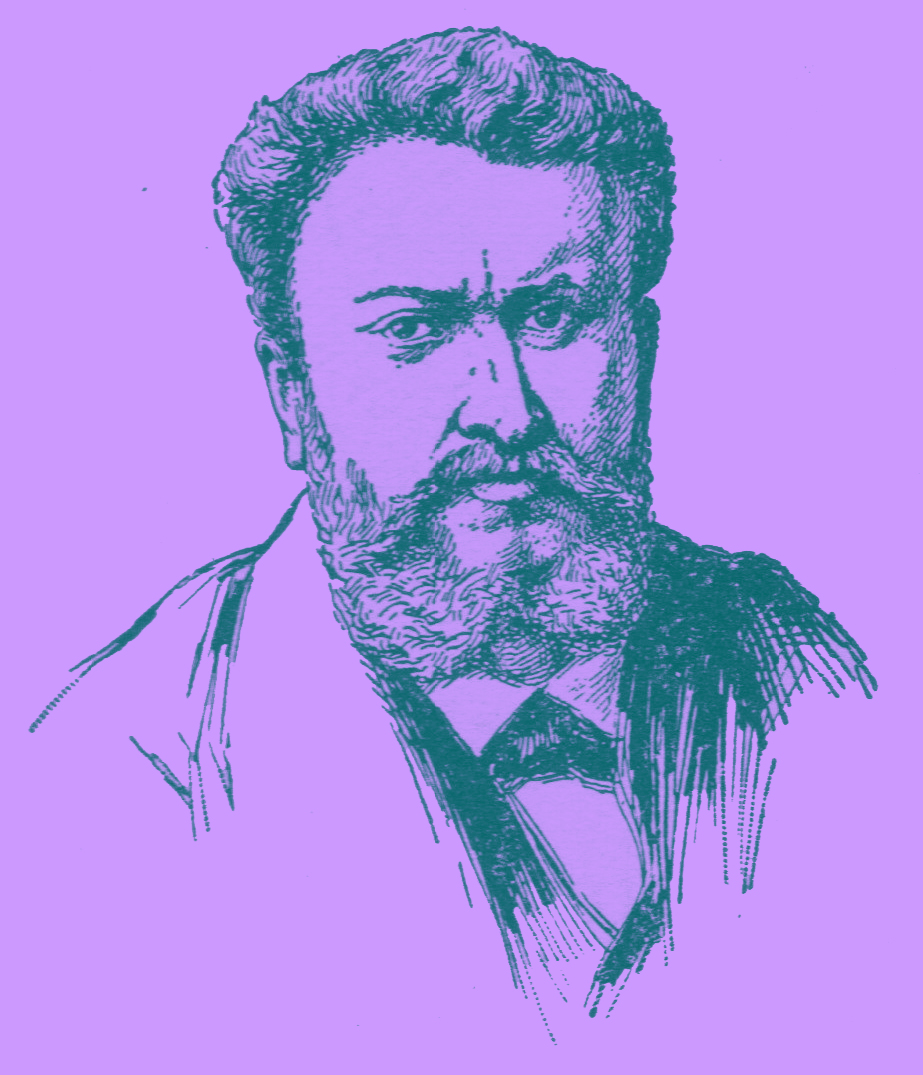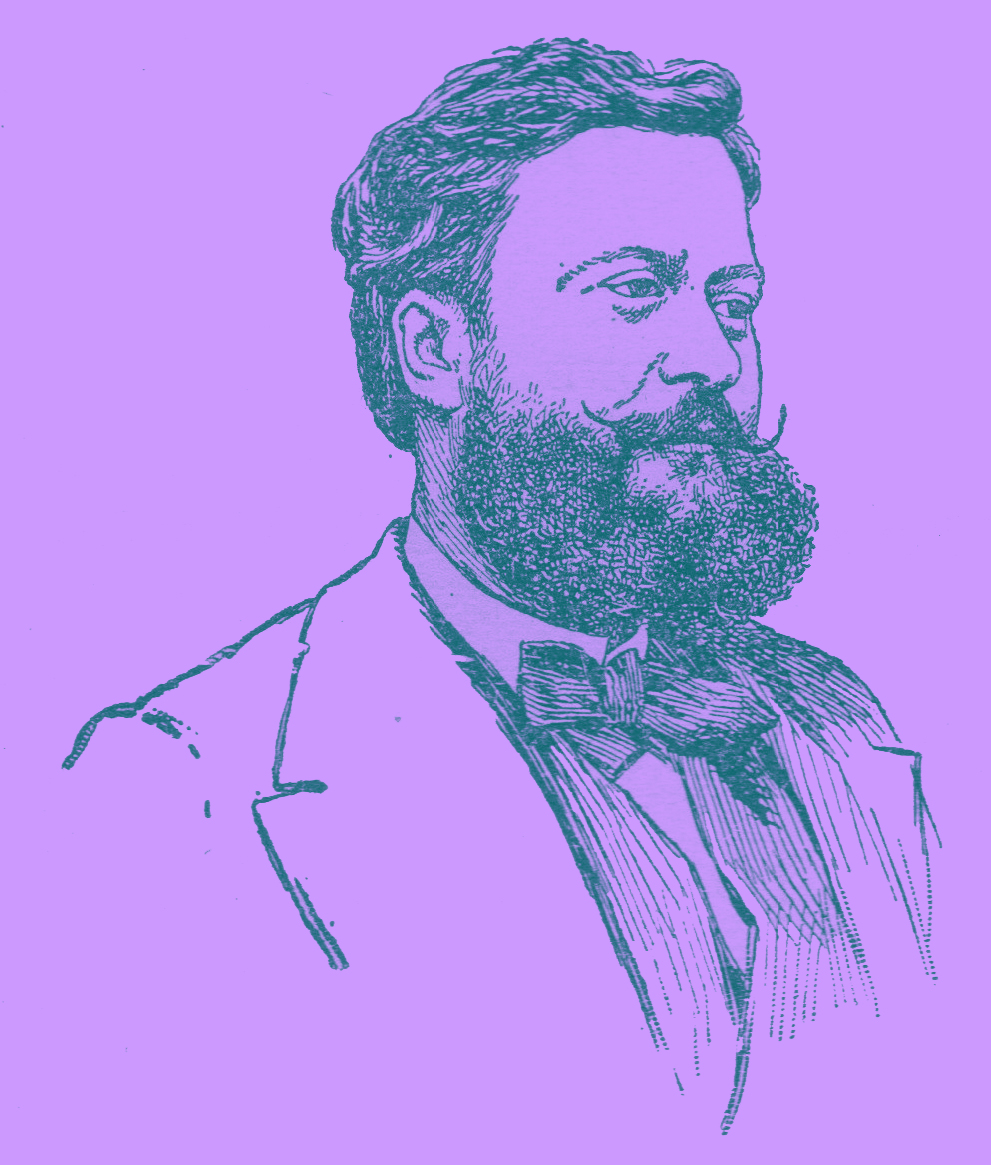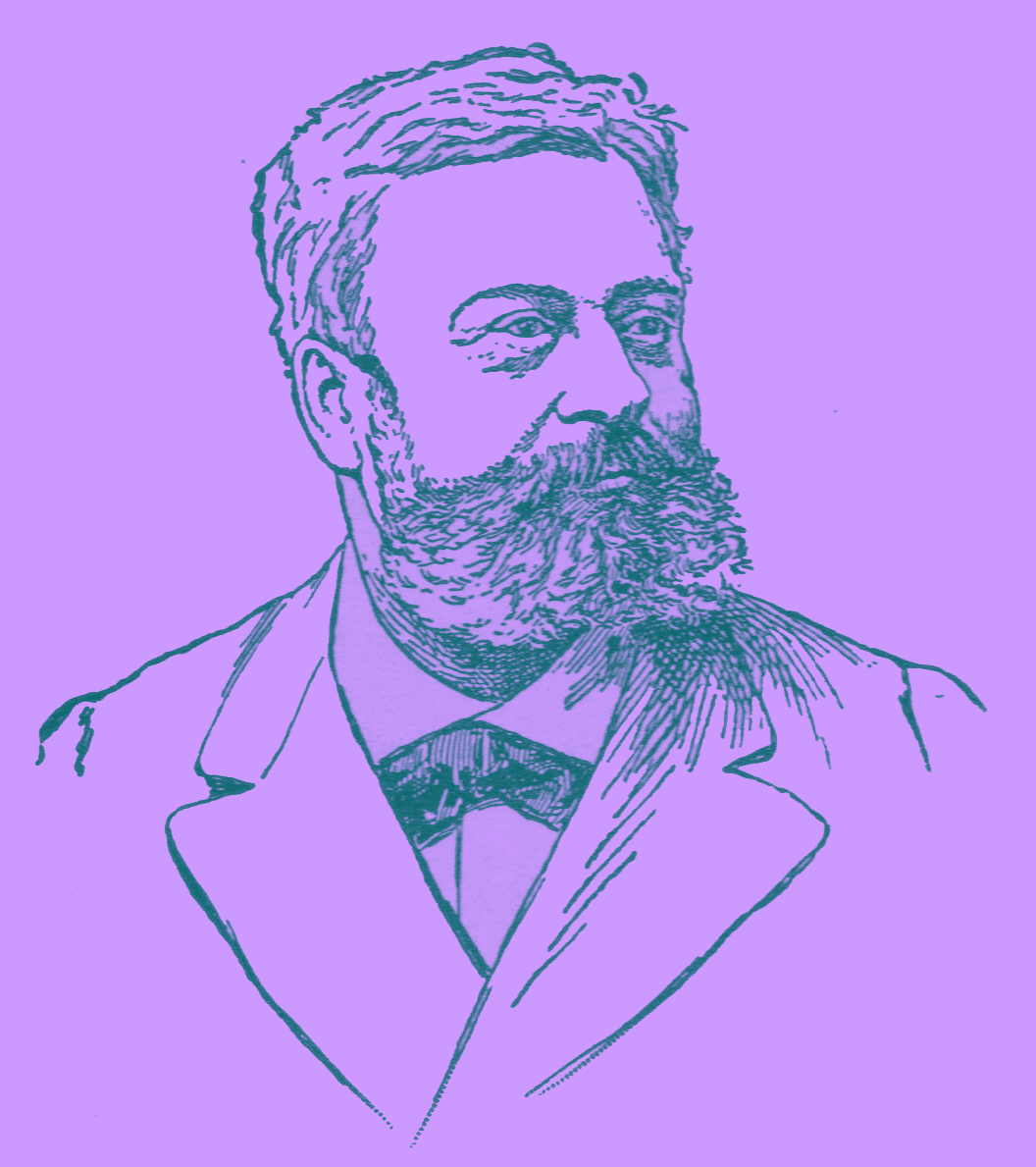·)(·)(·)(·)(·)(·)(·)(·)(·)(·)(·)(·)(·)(·)(·)(·)(·)(·)(·)(·)(·)(·)(·)(·)(·)(·)(·)(·)(·
From The King of the Mountains, by Edmond About, Translated from the French; with a Critical Introduction by Andrew Lang; a Frontispiece and Numerous Other Portraits with Descriptive Notes by Octave Uzanne; The French Classical Romances Complete in Twenty Crown Octavo Volumes, Editor-in-Chief Edmond Gosse, LL.D; New York : P. F. Collier & Son; 1902; pp. 307-317.
THE PORTRAITS OF
EDMOND ABOUT
_______

EDMOND ABOUT,
At the age of twenty-five.
After an unpublished portrait made at Naples
by Paul Baudry in 1853.
ASSUREDLY Edmond About was one of the most active men of letters; one of the most stirring, and the most censorious, in French politics under the Second Empire. Not only was he the head of that young generation of writers, who left the École Normale with an ambition to realize part of the Voltairian theories, but he also became the type of the impetuous journalist, irreducible and intransitive, such as existed in the days of that good-natured tyrant, Napoleon III. 308 With Émile de Girardin, he was the most dashing newspaper manager and chronicler that was to be found in Paris, at a period which was so rich in men of talent.
Edmond About, therefore, was relatively extremely popular; for he was a polygraph of extraordinary versatility, who in turn touched upon theatres and novels; was a satirical essayist, a contemporary historian, and a writer on questions of diplomacy and of social studies. He wrote alternately La Grèce Contemporaine, Maître Pierre, La Question Romain, Le Théâtre Impossible, Le Roi des Montagnes, Des Études sur les Artists au Salon de 1857, Un voyage à Travers l’Exposition Universelle de 1867, L’Homme à l’Oreille Cassée, and many other works, which it is out of our province to analyze here.
The life of a man of letters, flitting from one subject to another, and mixing in every society, explains the reason why Edmond About’s figure 309 was so often vulgarized in magazines and art reviews, political pamphlets, and publications of cheap novels.
The portraits of this master-writer, who was usually called the “direct heir of Voltaire,” were published in great numbers during the different periods of his life, and more particularly from 1860 to 1880.
We will not attempt an exact catalogue of these pictures; the greater part of them are only reproductions with slight variations of the same type of Edmond About, at that mature age when he was one of the best known and the most run after of the “boulevardiers” of the Second Empire. What we have endeavoured to gather together, in this little iconographic essay of the author of the Roi des Montagnes, is a collection of the rarer and less-known portraits of Edmond About, from his youth down to his last days. For this purpose we could not do better than to apply 310 to his widow, who lives surrounded by all the paintings, engravings, and photographs that were ever done of her lamented husband.
In answer to our request, Mme. About welcomed us cordially to her house, and placed at our disposal all her cherished mementoes, even down to the smallest unpublished sketch, which line the walls of her apartment in the Rue Mansart in Paris. It is these portraits mostly, carefully redrawn by a conscientious artist, that we reproduce here, and that we now propose to pass in review.
Edmond About left the École Normale in 1851, just about the time of the coup d’état of the 2d of December. We can understand then his ill-humour towards the Empire, which seemed to have shattered all the republican hopes of the young professor. The first portrait, here published for the first time, represents the youth at the age of twenty-five, when he had just made the acquaintance at Naples of the renowned young painter, Paul Baudry. This artist drew a 311 pencil sketch of his friend in morning dress; the shirt open at the throat, an irate expression, the mustache sulkily twisted over the lips, the whiskers waved like those of a little attaché of embassy. At this period About was going to the École Française of Athens, as one would go into exile, with a look of vengeance in his eyes, and a bitterness round the mouth; for he had hoped for better things than this career of professorship, which seemed at this moment to be his only perspective, and which possessed very little attraction for him. In this crayon drawing by Paul Baudry it is difficult to recognise the real type of Edmond About, which only becomes confirmed about five years later in the oil painting by Giacommetti, taken on the return of the young scholar from Athens, and after he had spent several months in Rome, no doubt collecting materials for his future study on the Eternal City.
This picture, painted in broad, bold touches, shows already a much more gentle look than that of Paul Baudry. The laughing face, the good-natured 312 expression so characteristic of Edmond About, is clearly seen in this portrait, which, moreover, is very distinctive of the period in which it was painted. These first works, taken from life, are those which give the most artistic whole of the countenance of the author of Germaine. We regret being unable to reproduce in colours Giacommetti’s picture. Painted against a yellow background, it is superb, both in colouring and execution.

EDMOND ABOUT,
At the age of thirty.
After a portrait painted at Rome by
Giacommetti in 1858, now repro-
duced for the first time.
We do not find its equivalent until a few years later, when Paul Baudry, meeting Edmond About again in Paris on the latter’s return from Russia, painted from his model of 1853, already old, since we believe the date to have been 1868, that marvellous portrait of Edmond About in a fur cap, looking like a powerful Hungarian Magyar. A copperplate engraving of it forms the frontispiece of this volume.

EDMOND ABOUT,
Copperplate Engraving from a portrait painted at Paris
by Paul Baudry in about 1868.
After 1860 Edmond About, great diffuser of knowledge that he was, became principally the 313 master journalist, the good-natured worker and companion, amiable, with a smile for every one, as we see him represented in the greater part of the engraved portraits which so frequently appeared on the fly-sheets or in advertisements of his novels. Thus is he shown to us in the print by O. Jahyer done about 1864.

EDMOND ABOUT,
About 1864.
After an engraving by O. Jahyer.
The face is notably softened, the forehead has expanded and the hair has that curl and the peculiar prominence over the temples which at that time was the fashionable mark of the “lions” of the Boulevard. The smile is sceptical and friendly, the eyes malicious, intellectual, tender almost. The beard frames well the full cheeks, and the whole appearance of the man gives an impression of happiness.
Some years later in the print by Geoffroy (1867), About looks already more worn.

EDMOND ABOUT,
About 1867,
After an engraving by Geoffroy
published in the magazine L’Artiste.
That year no doubt was for him a period of much fatigue; because in the portraits taken in the following years, as well as in the previous picture by Lehmann,

EDMOND ABOUT,
In 1860.
After a painting by Lehmann
not reproduced before.
314 the great master of that time, and also in a photograph by Carjat, we find About at the ages of thirty and forty superbly developed in strength, in smile, and in virility.

EDMOND ABOUT,
At the age of forty.
After a photograph by Carjat.
At the same time we think that the most truthful portrait, and the one which shows the author of Tolla in his real light, and reproduces best his fine plastic expression, is the drawing of the sarcastic journalist done by Émile Bayard some time before the Franco-German war, in that hour when fortune and success smiled on the amiable grandson of Voltaire.

EDMOND ABOUT,
In 1870.
After a drawing by Émile Bayard.
About was then at the very height of his fame. Carrier-Belleuse did a bust of him, which is not of much interest, and Crauk, the sculptor, modelled his head, but we cannot here reproduce these plastic documents. All the most reputed photographers and illustrators of Paris held it an honour to perpetuate the features of the author of Maître Pierre. Almost every literary circle had forgotten the dramatic mishaps of the theatrical writer of Gaëtana. The humorist who had published the Nez d’un Notaire 315 had completely reinstated himself in the good graces of the literary circles, and the students of Paris, who had formerly so maltreated him, were the first to applaud his glory, and his articles full of vehement criticism.
Edmond About with Francisque Sarcey, his intimate friend, his alter ego, so to speak, as chamberlain, was the literary king of Paris. Men vied with each other as to who should flatter him most; a few lines written by him and distributed among the young men of letters, conferred a reputation upon them at once. Carjat’s portrait on page 314 is very representative of the man we speak of : fully self-possessed, having realized his most cherished ambitions.

EDMOND ABOUT,
After an engraving by Carjat
about 1865.
As fame here below has always as its reverse side the search after the ridiculous and the exaggerated, the caricaturists naturally took possession of Edmond About’s personality. One could make a considerable collection of the satirical drawings which disfigured the æsthetic features of the author of L’Homme à l’Oreille Cassée, but we should not think of publishing here even a selection of 316 these caricatures. Such compositions are always like the symbols of events and actualities, from which they derive their origin, and of which they become the mysterious enigmas. Each of them would need an explanatory note, which would carry us far away from our subject. We publish only one caricature of Edmond About, drawn by André Gill, who was a master of the art, in the year 1875; because this portrait is synthetical of the direction of the XIX Century newspaper, which was the last political pamphlet founded by the great controversialist.

EDMOND ABOUT,
After a caricature by André
Gill in 1875.
The last portraits of Edmond About show him to us in his green old age, which has nothing decadent or even venerable in it. Up to his last hour the valiant novelist, like most men of thought and of active intellectual labour, preserved the appearance of strength and virility which does not abdicate. The last two figures seen in these pages, which were done in 1877 and 1880, go to prove the justice of our remarks. About is represented as a powerful Alsatian, 317 in whose hair and beard run the silver threads of old age, but without in any way detracting from the cleanness and firmness of the features.

EDMOND ABOUT,
In 1877,
After a photograph by Tourlin.
There comes, it is said, a time in life when the powers of the body become displaced and retire into the mind. With some men, as with Edmond About, those powers remain like potent forces maintaining intact till the day of death the expression of life, strenuous and headstrong.

EDMOND ABOUT,
From his last photograph taken by Liebert in 1880.
OCTAVE UZANNE.
·)(·)(·)(·)(·)(·)(·)(·)(·)(·)(·)(·)(·)(·)(·)(·)(·)(·)(·)(·)(·)(·)(·)(·)(·)(·)(·)(·)(·